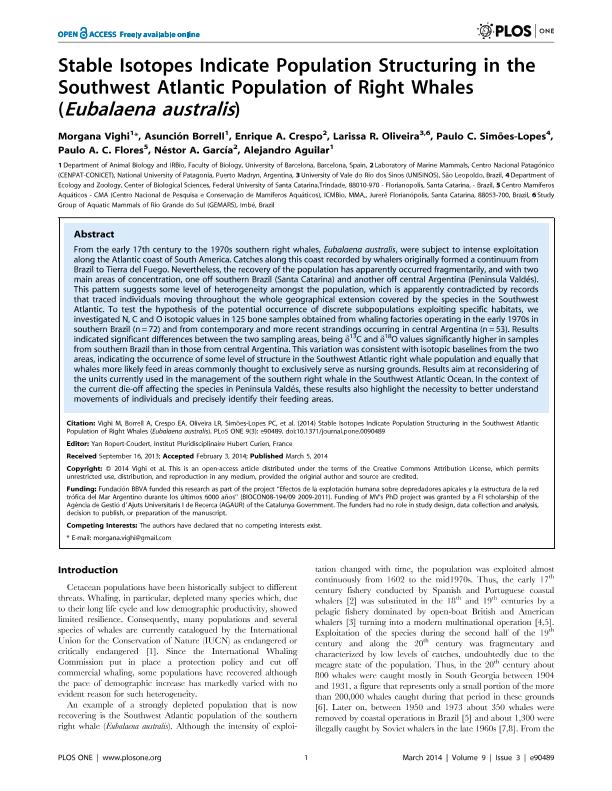Mostrar el registro sencillo del ítem
dc.contributor.author
Morgana, Vighi
dc.contributor.author
Borrell, Asunción
dc.contributor.author
Crespo, Enrique Alberto

dc.contributor.author
Oliveira, Larissa R.

dc.contributor.author
Simões Lopes, Paulo C.

dc.contributor.author
Flores, Paulo A. C.

dc.contributor.author
Garcia, Nestor Anibal

dc.contributor.author
Aguilar, Alejandro

dc.date.available
2017-06-02T15:55:44Z
dc.date.issued
2014-06-09
dc.identifier.citation
Morgana, Vighi; Borrell, Asunción; Crespo, Enrique Alberto; Oliveira, Larissa R.; Simões Lopes, Paulo C.; et al.; Stable isotopes indicate population structuring in the southwest Atlantic population of right whales (Eubalaena australis); Public Library of Science; Plos One; 9; 6; 9-6-2014; 1-8 e90489
dc.identifier.issn
1932-6203
dc.identifier.uri
http://hdl.handle.net/11336/17363
dc.description.abstract
From the early 17th century to the 1970s southern right whales, Eubalaena australis, were subject to intense exploitation along the Atlantic coast of South America. Catches along this coast recorded by whalers originally formed a continuum from Brazil to Tierra del Fuego. Nevertheless, the recovery of the population has apparently occurred fragmentarily, and with two main areas of concentration, one off southern Brazil (Santa Catarina) and another off central Argentina (Peninsula Valdés). This pattern suggests some level of heterogeneity amongst the population, which is apparently contradicted by records that traced individuals moving throughout the whole geographical extension covered by the species in the Southwest Atlantic. To test the hypothesis of the potential occurrence of discrete subpopulations exploiting specific habitats, we investigated N, C and O isotopic values in 125 bone samples obtained from whaling factories operating in the early 1970s in southern Brazil (n = 72) and from contemporary and more recent strandings occurring in central Argentina (n = 53). Results indicated significant differences between the two sampling areas, being δ13C and δ18O values significantly higher in samples from southern Brazil than in those from central Argentina. This variation was consistent with isotopic baselines from the two areas, indicating the occurrence of some level of structure in the Southwest Atlantic right whale population and equally that whales more likely feed in areas commonly thought to exclusively serve as nursing grounds. Results aim at reconsidering of the units currently used in the management of the southern right whale in the Southwest Atlantic Ocean. In the context of the current die-off affecting the species in Peninsula Valdés, these results also highlight the necessity to better understand movements of individuals and precisely identify their feeding areas.
dc.format
application/pdf
dc.language.iso
eng
dc.publisher
Public Library of Science

dc.rights
info:eu-repo/semantics/openAccess
dc.rights.uri
https://creativecommons.org/licenses/by-nc-sa/2.5/ar/
dc.subject
Eubalaena Australis
dc.subject
Southern Right Whale
dc.subject
Southwestern Atlantic
dc.subject
Stable Isotopes
dc.subject.classification
Conservación de la Biodiversidad

dc.subject.classification
Ciencias Biológicas

dc.subject.classification
CIENCIAS NATURALES Y EXACTAS

dc.title
Stable isotopes indicate population structuring in the southwest Atlantic population of right whales (Eubalaena australis)
dc.type
info:eu-repo/semantics/article
dc.type
info:ar-repo/semantics/artículo
dc.type
info:eu-repo/semantics/publishedVersion
dc.date.updated
2017-05-29T15:46:44Z
dc.journal.volume
9
dc.journal.number
6
dc.journal.pagination
1-8 e90489
dc.journal.pais
Estados Unidos

dc.journal.ciudad
San Francisco
dc.description.fil
Fil: Morgana, Vighi. Universidad de Barcelona; España
dc.description.fil
Fil: Borrell, Asunción. Universidad de Barcelona; España
dc.description.fil
Fil: Crespo, Enrique Alberto. Consejo Nacional de Investigaciones Científicas y Técnicas. Centro Científico Tecnológico Conicet - Centro Nacional Patagónico; Argentina
dc.description.fil
Fil: Oliveira, Larissa R.. Universidade Vale do Rio dos Sinos; Brasil. Universidade Federal do Rio Grande do Sul; Brasil
dc.description.fil
Fil: Simões Lopes, Paulo C.. Universidade Federal Santa Catarina; Brasil
dc.description.fil
Fil: Flores, Paulo A. C.. Centro Nacional de Pesquisa e Conservaçào de Mamíferos Aquáticos; Brasil
dc.description.fil
Fil: Garcia, Nestor Anibal. Consejo Nacional de Investigaciones Científicas y Técnicas. Centro Científico Tecnológico Conicet - Centro Nacional Patagónico; Argentina
dc.description.fil
Fil: Aguilar, Alejandro. Universidad de Barcelona; España
dc.journal.title
Plos One

dc.relation.alternativeid
info:eu-repo/semantics/altIdentifier/url/http://journals.plos.org/plosone/article?id=10.1371/journal.pone.0100024
dc.relation.alternativeid
info:eu-repo/semantics/altIdentifier/doi/http://dx.doi.org/10.1371/journal.pone.0100024
Archivos asociados
